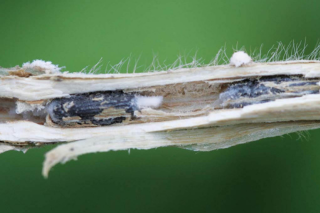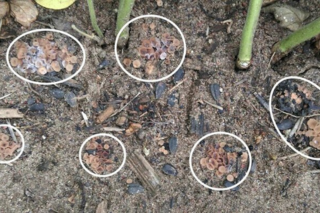Disease Prevention
Jul 21, 2025

It’s been a while since we’ve had a summer like this one- cooler and wet with rain seemingly every 3 days. Unfortunately, this is beginning to become the perfect environment for crop diseases. One of our biggest concerns this year? White mold in soybeans.
White mold is a disease spread by a fungus in the form of sclerotia. This sclerotia can survive from one year to the next in the soil, or in soybean residue. They will germinate and form tiny, tan-colored mushrooms on the soil surface. These mushrooms will produce spores that will travel by wind to the soybean plant, infecting it through the flowers, spreading to the stem. It is estimated that yield loss can be upwards of 40% if not controlled.
There are certain environments that favor white mold. A cooler, wet July while soybeans are flowering is the perfect start to the spread of this disease. Any field that has high soil fertility (think plenty of manure history), higher planting populations, narrow row spacing, white mold susceptible variety, and a field history of white mold all pose as risks to this year’s soybean crop.
There are steps we can take to manage the risks of yield loss that come with diseases. One that we would recommend at this time is a fungicide application. One of our favorite products is Endura when dealing specifically with white mold. Endura is a preventative fungicide that inhibits new growth of fungal cells while also blocking the energy production in existing cells. We do recommend adding the Winfield product MasterLock to the tank with the fungicide. MasterLock is an adjuvant that helps reduce fungicide evaporation and drift, meaning you get your product exactly where you need it.
Concerns of white mold or other diseases in your crops? Wanting more information on the fungicides we offer? Feel free to call our Melrose or Belgrade agronomy offices and one of our agronomists will be happy to help.
White mold is a disease spread by a fungus in the form of sclerotia. This sclerotia can survive from one year to the next in the soil, or in soybean residue. They will germinate and form tiny, tan-colored mushrooms on the soil surface. These mushrooms will produce spores that will travel by wind to the soybean plant, infecting it through the flowers, spreading to the stem. It is estimated that yield loss can be upwards of 40% if not controlled.
There are certain environments that favor white mold. A cooler, wet July while soybeans are flowering is the perfect start to the spread of this disease. Any field that has high soil fertility (think plenty of manure history), higher planting populations, narrow row spacing, white mold susceptible variety, and a field history of white mold all pose as risks to this year’s soybean crop.
There are steps we can take to manage the risks of yield loss that come with diseases. One that we would recommend at this time is a fungicide application. One of our favorite products is Endura when dealing specifically with white mold. Endura is a preventative fungicide that inhibits new growth of fungal cells while also blocking the energy production in existing cells. We do recommend adding the Winfield product MasterLock to the tank with the fungicide. MasterLock is an adjuvant that helps reduce fungicide evaporation and drift, meaning you get your product exactly where you need it.
Concerns of white mold or other diseases in your crops? Wanting more information on the fungicides we offer? Feel free to call our Melrose or Belgrade agronomy offices and one of our agronomists will be happy to help.
Sclerotia
